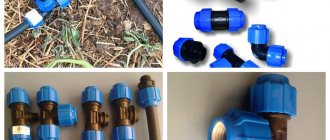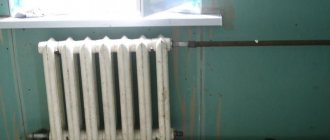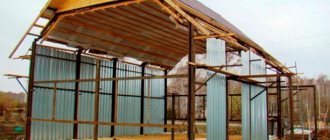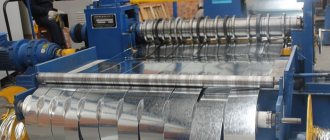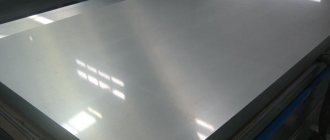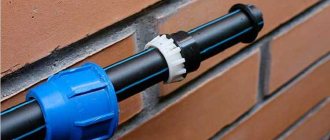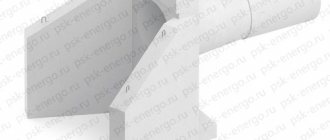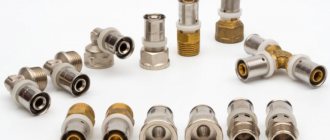Installation of a household pipeline involves the need to connect sections of pipes into a system of the desired configuration. A large number of different fittings have been developed for this purpose. Their choice depends on the pipeline material, its location and purpose. One of the convenient and simple types of pipeline installation is to fasten sections with collet fittings. They do not require special tools or skills, are available for self-installation, and are reliable.
Manufacturing materials
Fittings for pneumatic systems are made with threads from various types of materials, such as:
- various types of metal;
- stainless steel with increased resistance to acidic environments;
- modern generation technopolymers;
- combined materials.
Fittings made of stainless steel can be used at constant temperatures up to 200 degrees. The use of fittings made of various polymers significantly reduces the cost of the pipeline structure while maintaining all operational characteristics. The choice of connecting fittings presented on the modern market is quite large; here you can find collet connections, connections with nuts and other types.
Types of fittings for pneumatic systems
This is interesting: Ballerina on tiles: types and use of drills for large holes
How collet chucks work
To make a collet chuck, hardened tool steel is used. This ensures the high strength of the device, which will be used for a long time, during which workpieces or tools will be repeatedly attached and removed.
Collet chuck
The design of the collet chuck includes:
- frame;
- collet;
- compression ring;
- locknut.
The operating principle of all modifications, differing in standard sizes and device features, is the same: pressure is transferred from the clamping nut to the conical formation, and through it a radial compressive force is generated, directed at the clamped workpiece (tool, part).
The collet used gave the name to the most common collet chuck - ER. The advantages of a collet clamp over conventional chucks used in lathes (milling) machines are:
- simplifying the process of installing or removing a part (workpiece);
- the possibility of reliable fixation of a part with a small diameter;
- the ability to use solid inserts.
ER collet chuck with a set of collets of different diameters
The ER collet chuck is produced with a set of collets for workpieces of different diameters, which are installed depending on the specific dimensions of the shanks.
Classification of fittings
Connecting fittings of this type are classified according to the following criteria.
Connection fitting for pipes made of different materials
Material of manufacture
Depending on the material from which they are made, parts are:
- metal - from ferrous (cast iron and steel) and non-ferrous metals (brass and copper fittings for HDPE pipes);
- plastic.
Installation rules
According to the features of installation of fittings, they are divided into the following types:
- Threaded. Fastening is done using threads.
- Welded. The elements are connected by gas welding.
- Press fittings. They provide reliable joining, but require a special crimping tool.
- Collet adapters. In this case, the pipes are fixed using O-rings.
Let's take a closer look at the last type.
Types of collet connecting elements
Collet coupling.
Like other connecting parts, collet parts can be of the following types:
- Coupling or straight collet fitting . Used to connect unidirectional pipelines having the same diameter.
- Transition fitting - used to fasten the ends of pipes of different diameters.
- Angle, bend – are used to create rotations of the structure from 45 to 120 degrees.
- Crosspiece . Thanks to this element, a branching is made in two directions.
- Tee - used for one-way branch.
- A fitting is an adapter from a pipe to a hose.
- Plug – attached to the ends of the pipes.
Main varieties
- intended for connecting pipes made of polymer materials;
- used for connecting copper pipes.
Push-in fittings for copper pipes allow installation of pipelines without the use of welding or soldering
The design of the first type of fittings contains a fitting - a springy split sleeve. This element ensures that the pipe walls are pressed against the sealing ring placed on its outer surface. It is this bushing, the diameter of which must strictly correspond to the size of the internal section of the pipe, that gives the collet joint being created the required degree of tightness and reliability.
In the design of fittings intended for connecting copper pipes, there is no fitting onto which the pipe is placed. Otherwise, the design and operating principle of fittings of this type are practically no different from the corresponding characteristics of collet connecting elements for pipes made of other materials.
Straight and angled push-in fittings
Collet-type fittings can be used for joining individual sections of pipeline systems (collet couplings and fittings, straight collet fittings), for installing pipe branches (tees and crosses) and arranging corner joints of pipes.
Push-in connectors are made from a variety of materials, the most common of which are brass, polypropylene and high-strength polyethylene. To connect copper pipes, fittings also made of copper are used. Brass fittings can withstand high pressure (up to 25 Bar) and are successfully operated at high temperatures (up to 115°), but are susceptible to corrosion, so they are not recommended for installation of pipelines through which aggressive media are transported. In order to strengthen their design, individual elements of plastic collet fittings are made of metal. Such elements, in particular, are collet clamps, which are often made of stainless steel, as well as outer rings (cartridges), under which there is an internal plastic thread.
» data-lazy-type=»iframe» src=»data:image/gif;base64,R0lGODlhAQABAIAAAAAAAP///yH5BAEAAAAALAAAAAABAAEAAAIBRAA7″>
What are collets and fittings?
To understand the principle by which collet fittings work, you must first understand what a collet and a fitting are. A collet, the design of which is optimally suited to be used for connecting cylindrical parts, is a metal sleeve, on the side of which special cuts are made that form several spring petals. Thanks to the presence of such petals, the collet exerts pressure on the inner walls of the pipe, thereby pressing its outer surface against the walls of the fitting cartridge. Collet-type fittings operating according to the principle described above are often called clamp fittings.
Scheme of connecting pipes with a collet fitting
As for the fitting, this term refers to a connecting element used to create pipeline systems for various purposes. Fittings of appropriate design are used to solve various problems, which, in particular, include:
- connection of pipes of the same and different diameters;
- creation of corner connections in pipeline systems;
- connection of pipes with various plumbing devices and equipment (taps, filters, meters, pumps, etc.).
Main types of collet fittings
The high reliability that distinguishes the collet clamp for pipes is ensured not only by the collet itself, which exerts pressure on their internal walls, but also by the external fastening nut
A pipeline created using such connections is highly reliable, durable and, most importantly, leak-tight
Operational scope of pneumatic fittings
Pneumatic tubes and pneumatic fittings are used to create reliable connections in pneumatic systems. These systems can be varied and used for different purposes. In addition, it is worth noting that these connecting elements are also used in structures that pump previously filtered air.
These types of fittings are installed in systems where the pressure does not exceed 12 bar
They are also used when connecting individual elements of a water supply structure. This application justifies itself when you need to install a connection with maximum sealing performance. When installing a pneumatic connecting device on a water supply system, it is necessary to select the correct material for the manufacture of such a fitting. This is necessary in order to ensure a long service life of both the fitting and the plumbing structure as a whole.
Pneumatic connecting parts that are used in systems transporting filtered air can withstand internal pressures of up to 12 bar. The temperature resistance of such devices ranges from −10 to +70 °C. The material used for such pneumatic fittings is acetal high-tech plastic, which has high technical characteristics.
Pneumatic fittings are made of polymers and are used in various industries. In production they are used for joining elements of systems that transport and process compressed air or other gas.
Let's look at the main devices that use the following connecting elements:
- pneumatic valves and cylinders;
- regulators;
- filters and microfilters.
Pneumatic fittings come in a wide variety of types and configurations
This is interesting: Hydraulic sheet bending: types of machines, features of their design, popular models
Collet clamp
The use of a collet clamp for pipes can significantly simplify the pipeline assembly process and significantly reduce its cost, eliminating the need for the services of third-party specialists.
There are three types of this connecting element according to its purpose for certain types of structures:
- soft;
- semi-solid;
- solid.
The type of pipe clamping collet is selected based on what material was used for its manufacture:
- metal;
- plastic;
- polypropylene, etc.
Having specified the diameter of the pipe, you can begin assembling the structure.
Note! The only limitation is that it is not customary to install a direct clamping collet in hard-to-reach places. The reason is this: such structures need periodic inspection and tightening of loose elements, so access to them should be easy.
Collapsible direct clamp design
The pre-assembled direct clamp design is easy to install. A springy split sleeve presses on the pipe from the inside, and the sealing ring is pressed on top by a lock nut. Through the ring, the clamping force is transmitted to the pipe walls, which are tightly clamped to the sleeve.
Features of application
The peculiarity of the collet connection is that over time the clamp weakens and the pipeline begins to leak. This defect can be easily eliminated - the nut should be tightened using a wrench, while the fitting body is also held with an adjustable wrench.
We recommend that you read: How does a heating air valve work and how to choose it?
Given this feature, care should be taken to ensure that the collet connection is located in a place that is convenient for access. The tightness of the pipeline should be checked periodically.
Advantages and disadvantages
Collet-type fittings have become widespread due to a number of advantages that they possess.
- Fittings of this type can be used for installation of pipelines through which media with temperatures up to 170° are transported.
- Hydraulic and pneumatic collet-type fittings are capable of withstanding pressure in the pipeline system, the value of which is 15 atmospheres.
- Using the products in question, you can connect pipes with an internal diameter in the range of 8–100 mm.
- In order to perform a high-quality installation of a collet fitting, no special skills or experience in working with pipe connections are required. The tools used to perform this procedure can be conventional open-end or gas wrenches.
- This type of straight push-in connector or elbow fitting requires minimal time to install. In terms of installation speed, collet-type fittings have no equal among products of similar purpose.
One of the most significant disadvantages of collet fittings is the already mentioned above impossibility of using them for the installation of pipes, the material of which is characterized by low ductility.
Reliable, easy to install and maintain, collet-type fittings are today used to connect copper, metal-plastic, plastic tubes and pipes almost everywhere. Thus, connecting elements of this type are used for the installation of pneumatic and vacuum systems, as well as for the arrangement of water supply and heating pipe lines. With the help of collet fittings, capable of withstanding high temperatures and significant pressure, reliable and tight connections are created between pipe lines of various devices, compressor and gas turbine equipment.
» data-lazy-type=»iframe» src=»data:image/gif;base64,R0lGODlhAQABAIAAAAAAAP///yH5BAEAAAAALAAAAAABAAEAAAIBRAA7″>
Installation technology
When installing pipes using collet fittings, it is necessary to fix the collet into the inside of the structure. The outer nut is screwed using an adjustable wrench. Thus, an optimal level of structural tightness is achieved. The same actions are performed with the second part of the structure.
It should be remembered that these elements exert considerable pressure on the structure. For this reason, if plastic pipes are installed, the clamping level should be monitored. If excessive force is used, the structure can become severely deformed. For this reason, you must try to regulate your efforts to prevent cracks from occurring in the product. If you would like to learn more about the features of these crimping devices and the specifics of their installation, you can always look at photos on this topic.
Product characteristics
During installation, two types of fittings can be used:
- with threaded fasteners;
- collet.
The material used for their manufacture is stainless steel, various alloys (bronze, brass), technopolymers.
Fittings for any pneumatic systems are used in devices whose operating principle is based on the use of compressed air energy. In order to ensure complete tightness of the system and prevent loss of power of operating equipment, reliable pneumatic tubes and fittings are required.
Today, industrial enterprises specializing in the production and supply of pneumatic tubes and fittings offer a wide range of this type of product.
There are two main types of such products:
- Fittings whose purpose is to control the flow of compressed air (gas). They can change the physical characteristics of substances passing through the system in devices such as pneumatic throttles, mufflers, consumption (flow) regulators, etc.
- Push-in fittings, which require a minimum amount of time for installation (disassembly) and are used mainly for connecting individual parts of a system consisting of many tubes.
Application area
Pneumatic tubes and fittings are necessary for monitoring and reliable sealing in a variety of pneumatic systems. They are also installed in systems for transporting (pumping) air that has been previously filtered.
Their use is also possible in water supply systems, when it is necessary to create an absolutely tight connection.
In the latter case, special attention should be paid to the material from which the connectors are made, since the integrity of the entire system (its tightness) will depend on their wear resistance under various operating conditions.
MV pneumatic fittings are used in systems that operate with filtered air. Such connectors can withstand internal pressure up to 12 bar, and do not lose their performance characteristics at temperatures from -10 to +70ºC.
The material used to manufacture such fittings is high-tech plastic, and the connection types are threaded or quick-release collet.
The plastic used in the manufacture of such products consists of an acetal polymer, whose properties far exceed the functional properties of conventional polymer or metal.
Such models are characterized by resistance to corrosion and have a high level of rigidity. Produced in various standard diameters.
Polymer pneumatic fittings are widely used in industry, where they can be installed in systems for the preparation, transportation, processing of compressed air or other gaseous substances.
The main devices on which such connectors are often used are regulators, pneumatic valves, pneumatic cylinders, filters, microfilters, lubricators and other similar mechanisms.
Types of pneumatic connections
The following types of connections are most often used:
- brush with various types of threads;
- adapters for various pipe sizes;
- corner joining of pipes with internal and external threads;
- corner joints with a combined thread structure;
- tees of different sizes with a combined thread system;
- tees with standard thread;
- T- and Y-shaped tees with various types of threads;
- cross fittings;
- couplings for changing from size to size; Pneumatic fittings for similar systems
- adapters with external thread;
- various types of plugs;
- drain valves, quick-release connections with various standard threads;
- fittings for connecting hoses;
- quick release fittings;
- ball valves.
Pneumatic tubes and fittings are used as reliable connections:
- polyurethane pneumatic tubes. They are very resistant to any mechanical loads - twisting, squeezing, bending. Such tubes quickly return to their original appearance, they are resistant to oil and any type of fuel, and microbes do not multiply on them. The disadvantage is instability to acidic environments;
- pneumatic tubes made of polyamide are of high quality polymer; they are very durable and at the same time flexible, and can be used with a fairly large range of operating temperatures. Can be used for transporting gases, alkalis, oil, fuel.
A large assortment of such products makes it easy to select a part for any industrial equipment.
Material of manufacture and main types of connectors
All types of pneumatic fittings can be made of polyamide (nylon and rilsan), Teflon, polyethylene, polyurethane. Nickel-plated steel, copper, and stainless alloys are often used in production. Brass pneumatic fittings can be used provided there is no exposure to an aggressive environment.
Connectors that are designed for sealed pneumatic systems are divided into the following types:
- straight;
- corner;
- tees;
- splitters;
- adapters.
Metal, plastic and bronze collet fittings for pneumatic systems (tees, couplings, bends, splitters)
The following types are most in demand:
- a brush that has external and internal threads;
- adapter for connecting tubes of different diameters;
- corner with internal or external thread;
- combined angle (external and internal thread);
- tees with internal or external thread;
- combined tees;
- T and Y shaped tees with different thread locations;
- cruciform connections;
- transition couplings;
- external threaded adapters;
- plugs;
- hose connectors;
- quick release fittings;
Special tubes are used in combination with pneumatic fittings:
- Polyurethane. They are resistant to mechanical stress (twisting, squeezing, bending). When subjected to physical impact, they are quickly restored to their original form. Not subject to hydrolysis, resistant to oils, ozone, microorganisms, and different types of fuel. The only drawback is that they are susceptible to the influence of acids.
- Polyamide (rilsan). They are very flexible and durable at the same time. They do not lose their properties at temperatures from -10 to +70ºC. They withstand the effects of alkali, gas, fuel, and machine oil.
Wide selection of types of polyurethane tubes for connecting pneumatic systems
Installation of collet fittings
An example of connecting two metal-plastic pneumatic tubes using a collet-type pneumatic fitting:
- Cut two tubes to the required length using special scissors.
- Calibrate the tube opening using a calibrator.
- Remove the chamfer from the inner surface of the tube using a chamfer remover.
- Check the presence and quality of the dielectric gasket and two rubber sealing rings on the fitting shank.
- Place the union nut and then the collet onto the first tube.
- Insert the fitting shank into the hole in the tube until it stops.
- Hand tighten the union nut onto the fitting body.
- Repeat steps 5, 6 and 7 for the second tube.
- Tighten the union nuts on the fitting body using a spanner, leaving 1-1.5 threads free.
- Installation is complete.
Collet pneumatic parts (fittings) are designed for durable connections without leakage of air or other working media in pneumatic systems.
A wide range of products makes it possible to choose a wide variety of manufacturing materials and allows the use of collet pneumatic fittings in various equipment, ensuring reliable fastening and tightness of the connection.
Installation
Installation of collet connections is the simplest possible. Classic threaded fittings rival in ease of installation, but you must seal the connection yourself (using tape or flax tow). Moreover, this will need to be done again each time if you need to disassemble the unit. In the case of a collet fitting, there is no such need.
To work you will need:
- scissors for plastic pipes or a hacksaw for metal;
- calibrator with bevel remover;
- wrench or wrench.
Let's look at the installation of a collet connection using the example of a metal-plastic pipe. The scheme of work is as follows:
- cut off the pipe;
- align the circle by putting the pipe on the calibrator and turning it;
- remove the internal chamfer (necessary to ensure that an uneven cut does not damage the o-rings on the fitting);
- disassemble the fitting by removing the nut and collet ring;
- put the nut and ring on the pipe in the order described;
- Pull the pipe onto the fitting until it stops;
- move the collet into place;
- tighten the nut.
How to install
To install a fitting connection at home, you need to have a pipe, a fitting, scissors or a hacksaw for metal, and a deburring knife.
In production they use a pipe flaring machine, but at home you can do without it. Place the nut on the pipe, insert the spacer ring, insert the fitting and tighten the union nut with a wrench.
Each type has its own installation methods, which we will consider below.
Compression
All types of compression fittings are assembled the same way. The tightness is ensured by a crimp ring, which creates pressure on the metal-plastic pipe. To ensure a strong connection, tighten the union nut until it stops.
Monitor the presence of a Teflon insulating gasket and two rubber rings in the housing.
Crimping
This type of sealing works on the principle of uniform compression of a pipe with a metal ring from the outside to the inside. To create a strong connection, you must adhere to certain rules:
- cut pipes at right angles;
- clean burrs from the inside and outside;
- use a calibrator;
Before assembly:
- Put the nut on.
- Remove burrs with sandpaper or a knife.
- Flare the hole with a calibrator.
- Put on the clamping split ring.
- Insert the fitting body into the pipe.
- Tighten the nut first with your hands and then with a wrench.
A strong connection is ready.
Collet
The collet clamp works due to a split collet sleeve, which has petals. When screwed onto the body, the nut presses the split petals and thereby ensures tightness. The principle of operation of the collet is identical to the lead clamp in a mechanical pencil. When the metal sleeve moves onto the collet, the pipe is clamped. The connection principle is identical to crimp connections and is carried out in the same order.
Threaded
Threaded fittings are used to connect metal pipelines. Their only advantage is their low cost. To connect pipes, it is necessary to cut a thread at its ends with a clamp, weld or solder a bend. In order to connect two pipes, a coupling with a lock nut is screwed onto their ends. Sealing of the connection is ensured by winding flax tow onto the threads and coating with sealing paste. If it is not possible to cut threads directly on site, then you have to weld threaded bends at the ends of the pipes. Due to the complexity of the installation process, these connections are being replaced by others: compression, collet, crimp.
Features of installation of other types
To connect copper pipes, the capillary soldering method is used. The difference is that: bends, tees, angles, bends-adapters, corners and couplings are immediately prepared for soldering and do not require flaring.
During production, they already have the hole flared. You just need to insert a piece of copper tube and solder it. To do this, use a gas torch and solder. Despite the fact that soldering such connections requires special skills, copper piping is popular for heating installations.
With proper soldering, copper pipe systems can last up to 80-100 years.
Nuances of socket connection of parts
The socket method of connecting parts is very simple. The edge of one pipe has a larger diameter; it is this that forms the socket into which the end of the other element is inserted. To make the connection airtight, a special rubber ring seal is used that is inserted into the socket, or another sealant. Installing a pipeline with connections of this type is not particularly difficult and resembles assembling a construction set. There are different types of socket joints.
Option #1 - without O-ring
The method is very often used to connect sewer cast iron pipes. Parts are measured. The inserted element is laid on wooden blocks and sawed along the intended line. The end of the outer part of the part must be free of cracks or nicks and strictly perpendicular to the axis of the pipe. The prepared pipe is inserted into the socket. The gap inside it must be sealed. Oiled hemp or tarred flax is used as a sealant. The first layer is inserted into the pipe with a ring, so that the ends of the strands do not get inside the part. The seal is caulked using a hammer and screwdriver.
The remaining layers of material are laid in the same way until approximately two-thirds of the depth of the socket is filled. The last layer is laid with a sealant without impregnation, which may interfere with adhesion to the solution. The remaining distance to the end of the pipe is filled with cement mortar or asbestos-cement mixture, bitumen mastic and similar compositions.
To seal the socket joint of pipes without a sealant, tarred flax or oiled hemp is used
Option #2 - with an O-ring
It is considered one of the main methods of connecting plastic pipes. In this case, the tightness is ensured by a rubber ring, which is clamped between the straight end of the pipe and the walls of the socket. The seal, which can be either with or without special plastic liners, allows you to partially compensate for possible misalignment of the axes of the connected parts. However, uneven deformation of the sealing band on the ring can cause leaks in the joint area. Therefore, the curvature of the axis should be no more than the thickness of the pipe wall per each linear meter of the pipeline.
When installing a socket connection with an o-ring, you need to ensure that the centers are aligned. Otherwise, the distortion of the pipe will provoke deformation of the seal and, as a result, insufficient sealing of the connection
Some manufacturers produce models of tees and elbows not at a straight line, but at an angle of 87°. Thus, a pipe laid on a slope enters the socket without distorting the ring. During installation, to prevent damage to the seal, a chamfer is made on the smooth end of the pipe and lubricated with soap, glycerin or silicone. Oils are prohibited. The socket connection with the sealing ring is performed as follows:
We check the presence of an o-ring in the socket and a chamfer on the smooth end of the pipe
We clean the parts from possible contamination and apply lubricant. We place the smooth edge of the structure until it stops in the socket and put a mark. Carefully remove the part from the socket, extending it no more than 11 mm, while focusing on the previously placed mark. The resulting gap will compensate for temperature changes in the pipe length
On average, one bell compensates for the elongation of a two-meter fragment of the pipeline.
If it is necessary to connect pipes made of different materials using this method, special adapter pipes are used.
Option #3 - socket method using welding
Contact socket welding is intended for plastic parts and is carried out using special equipment. During the joining process, a mechanical or manual welding machine is used, equipped with special devices for heating the elements. This is a mandrel designed to melt the inner surface of the part, and a sleeve that heats the outer part of the pipe.
Polypropylene pipes are connected by socket welding. For this procedure, a special welding machine is used, which heats the parts to the required temperature.
The connection process is quite simple. A sleeve-mandrel set is selected that corresponds to the diameter of the pipes being connected. The devices are installed on the device platform and heated. The parts are put on the equipment and heated to the required temperature. Once this has been achieved, the elements are quickly and carefully removed and connected with a precise movement until they stop. The connection is left motionless until the plastic cools and completely hardens.
Pneumatic Pipe Clamps
Push-in fittings can be used to connect pipes in pneumatic systems, that is, those that are pressurized by compressed air. Naturally, a sealed connection can be ensured by parts that are capable of operating at such pressure. To make clamps for this use you will need:
- high-tech plastic based on acetate polymer. Such products are used in air filtration systems. The clamps are resistant to corrosion and have a high degree of rigidity. They are used in conditions where the operating temperature range is set at levels from -10º C to +70º C, and the operating pressure reaches twelve atmospheres;
- other polymers (polyamide, polyurethane, polyethylene, Teflon);
- metals and alloys (brass, copper, steel, stainless alloys).
Pneumatic Pipe Clamps
With pneumatic push-in fittings, the piping system can be quickly assembled or disassembled. They are extremely reliable, resistant to high pressure and a wide range of temperatures.
Important! Despite all their advantages, these are very specific products that can only be installed in certain operating systems and only for certain purposes. Their use in the same pneumatic systems for the purpose of controlling the circulating flow of compressed air or gas is excluded.
